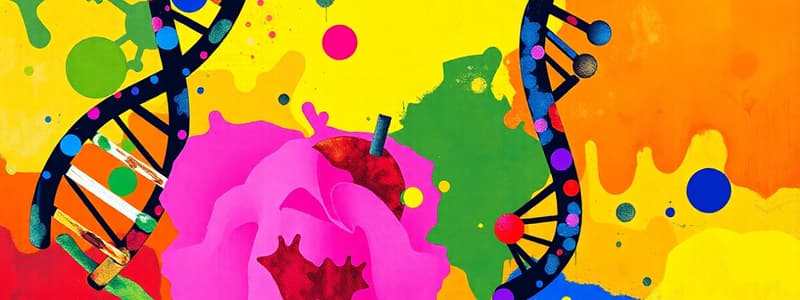Podcast
Questions and Answers
What is a primary characteristic of evolution?
What is a primary characteristic of evolution?
- It is a change in population size.
- It involves learning new behaviors.
- It is the genetic change in a species over time. (correct)
- It occurs only in response to environmental changes.
Which sugar component distinguishes RNA from DNA?
Which sugar component distinguishes RNA from DNA?
- Glucose
- Fructose
- Deoxyribose
- Ribose (correct)
What process is illustrated by boiling an egg?
What process is illustrated by boiling an egg?
- Hydrolysis
- Condensation
- Fermentation
- Denaturation (correct)
Which of the following organisms may possess RNA as their only genetic material?
Which of the following organisms may possess RNA as their only genetic material?
Which of the following is NOT a method of observation in biology?
Which of the following is NOT a method of observation in biology?
What is the term for the transmission of characteristics from parent to offspring?
What is the term for the transmission of characteristics from parent to offspring?
What is the term used to describe the process of using and transforming energy in living organisms?
What is the term used to describe the process of using and transforming energy in living organisms?
What do we call the ability of living organisms to maintain stable internal conditions?
What do we call the ability of living organisms to maintain stable internal conditions?
What is a group of different tissues that work together in a multicellular organism called?
What is a group of different tissues that work together in a multicellular organism called?
What term describes all the populations of a particular kind of organism?
What term describes all the populations of a particular kind of organism?
What is the proper order for the hierarchy of increasing complexity?
What is the proper order for the hierarchy of increasing complexity?
What biological process is responsible for much of the diversity among flowering plants and their insect pollinators?
What biological process is responsible for much of the diversity among flowering plants and their insect pollinators?
What type of reasoning do scientists use when forming new hypotheses?
What type of reasoning do scientists use when forming new hypotheses?
What is the correct sequence of steps in the scientific process?
What is the correct sequence of steps in the scientific process?
What genetic material is all organisms' genetic systems based on?
What genetic material is all organisms' genetic systems based on?
Which of the following characteristics of water molecules contributes to its high heat of vaporization?
Which of the following characteristics of water molecules contributes to its high heat of vaporization?
Which kingdom is known for containing photosynthetic organisms that primarily live in aquatic environments?
Which kingdom is known for containing photosynthetic organisms that primarily live in aquatic environments?
What is the mass number of an atom defined as?
What is the mass number of an atom defined as?
Which kingdom includes organisms that are unable to perform photosynthesis and digest food externally?
Which kingdom includes organisms that are unable to perform photosynthesis and digest food externally?
How many neutrons are present in an element with an atomic number of 6 and a mass number of 14?
How many neutrons are present in an element with an atomic number of 6 and a mass number of 14?
Which kingdom is characterized by non-photosynthetic organisms that digest their food internally?
Which kingdom is characterized by non-photosynthetic organisms that digest their food internally?
Which group comprises the simplest organisms that lack a nucleus?
Which group comprises the simplest organisms that lack a nucleus?
What are proteins made up of?
What are proteins made up of?
Which particle is primarily responsible for the chemical behavior of atoms?
Which particle is primarily responsible for the chemical behavior of atoms?
What is the term for the region around a nucleus where electrons are likely to be found?
What is the term for the region around a nucleus where electrons are likely to be found?
Which level of protein structure determines all other levels?
Which level of protein structure determines all other levels?
What are atoms that have a positive or negative charge called?
What are atoms that have a positive or negative charge called?
What are most enzymes classified as?
What are most enzymes classified as?
What type of sugar is found in DNA?
What type of sugar is found in DNA?
What carbohydrate do plants primarily use for energy storage?
What carbohydrate do plants primarily use for energy storage?
What term describes fatty acids that have the maximum number of hydrogen atoms possible?
What term describes fatty acids that have the maximum number of hydrogen atoms possible?
Which molecule is a primary component of cell membranes?
Which molecule is a primary component of cell membranes?
Which theory explains that individuals with advantageous traits are more likely to reproduce?
Which theory explains that individuals with advantageous traits are more likely to reproduce?
What process proposed by Charles Darwin involves the survival and reproduction of individuals with favorable traits?
What process proposed by Charles Darwin involves the survival and reproduction of individuals with favorable traits?
Most elements in nature exist as:
Most elements in nature exist as:
When an electron is transferred from one atom to the next, and the two atoms are then electrically attracted to one another, the type of bond is a(n) ____ bond.
When an electron is transferred from one atom to the next, and the two atoms are then electrically attracted to one another, the type of bond is a(n) ____ bond.
What is the name for groups of cells that share a similar structure and function?
What is the name for groups of cells that share a similar structure and function?
The type of bond that forms between two atoms when electrons are shared is a(n) ____ bond.
The type of bond that forms between two atoms when electrons are shared is a(n) ____ bond.
Weak chemical attractions that form when molecules are very close together are called ____.
Weak chemical attractions that form when molecules are very close together are called ____.
A solution with a pH of 3 is highly ____.
A solution with a pH of 3 is highly ____.
Flashcards
Evolution
Evolution
The process of gradual changes in the genetic makeup of a population over generations.
Denaturation
Denaturation
The process of altering the structure of a protein, often due to heat or pH changes, rendering it inactive.
RNA vs. DNA
RNA vs. DNA
RNA differs from DNA in its sugar molecule (ribose vs deoxyribose) and the use of uracil (U) instead of thymine (T) as a base.
Radioactive Isotopes
Radioactive Isotopes
Signup and view all the flashcards
Applications of Radioactive Isotopes
Applications of Radioactive Isotopes
Signup and view all the flashcards
Water's Polarity
Water's Polarity
Signup and view all the flashcards
Hydrogen Bonding in Water
Hydrogen Bonding in Water
Signup and view all the flashcards
Plantae Kingdom
Plantae Kingdom
Signup and view all the flashcards
Fungi Kingdom
Fungi Kingdom
Signup and view all the flashcards
Animalia Kingdom
Animalia Kingdom
Signup and view all the flashcards
Heredity
Heredity
Signup and view all the flashcards
Metabolism
Metabolism
Signup and view all the flashcards
Homeostasis
Homeostasis
Signup and view all the flashcards
Organ
Organ
Signup and view all the flashcards
Species
Species
Signup and view all the flashcards
Hierarchy of Complexity
Hierarchy of Complexity
Signup and view all the flashcards
Cooperation in Nature
Cooperation in Nature
Signup and view all the flashcards
Inductive Reasoning
Inductive Reasoning
Signup and view all the flashcards
Scientific Method
Scientific Method
Signup and view all the flashcards
DNA as the Genetic Basis
DNA as the Genetic Basis
Signup and view all the flashcards
What are proteins made of?
What are proteins made of?
Signup and view all the flashcards
What determines a protein's structure?
What determines a protein's structure?
Signup and view all the flashcards
What are most enzymes made of?
What are most enzymes made of?
Signup and view all the flashcards
What sugar is in DNA?
What sugar is in DNA?
Signup and view all the flashcards
What's the plant energy storage?
What's the plant energy storage?
Signup and view all the flashcards
Isotopes
Isotopes
Signup and view all the flashcards
Ionic Bond
Ionic Bond
Signup and view all the flashcards
Covalent Bond
Covalent Bond
Signup and view all the flashcards
Van der Waals Forces
Van der Waals Forces
Signup and view all the flashcards
Hydrophobic
Hydrophobic
Signup and view all the flashcards
What is the mass number?
What is the mass number?
Signup and view all the flashcards
How to find the number of neutrons
How to find the number of neutrons
Signup and view all the flashcards
What determines how atoms react?
What determines how atoms react?
Signup and view all the flashcards
What is an orbital?
What is an orbital?
Signup and view all the flashcards
What is an ion?
What is an ion?
Signup and view all the flashcards
Saturated fatty acid
Saturated fatty acid
Signup and view all the flashcards
Phospholipids
Phospholipids
Signup and view all the flashcards
Theory of Evolution
Theory of Evolution
Signup and view all the flashcards
Natural Selection
Natural Selection
Signup and view all the flashcards




